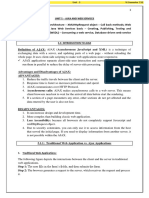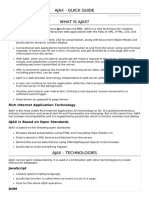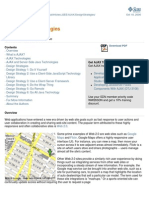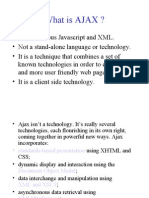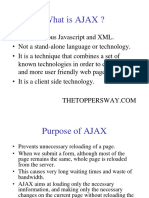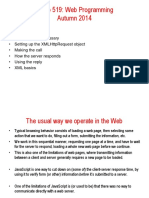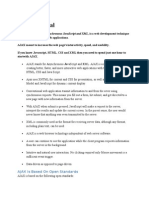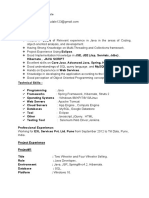0% found this document useful (0 votes)
45 views8 pagesAJAX Architecture Final
The document introduces Asynchronous JavaScript Technology and XML (AJAX), which allows web pages to asynchronously fetch XML data from servers to update the Document Object Model (DOM) without reloading the entire page. It discusses the benefits of AJAX, such as real-time form validation and dynamic user interfaces, while also highlighting challenges like complexity and debugging difficulties. The document outlines the anatomy of an AJAX interaction using Java 2 Platform, Enterprise Edition (J2EE) technologies, providing a detailed example of how AJAX can be implemented in web applications.
Uploaded by
maulikshoppingCopyright
© © All Rights Reserved
We take content rights seriously. If you suspect this is your content, claim it here.
Available Formats
Download as DOC, PDF, TXT or read online on Scribd
0% found this document useful (0 votes)
45 views8 pagesAJAX Architecture Final
The document introduces Asynchronous JavaScript Technology and XML (AJAX), which allows web pages to asynchronously fetch XML data from servers to update the Document Object Model (DOM) without reloading the entire page. It discusses the benefits of AJAX, such as real-time form validation and dynamic user interfaces, while also highlighting challenges like complexity and debugging difficulties. The document outlines the anatomy of an AJAX interaction using Java 2 Platform, Enterprise Edition (J2EE) technologies, providing a detailed example of how AJAX can be implemented in web applications.
Uploaded by
maulikshoppingCopyright
© © All Rights Reserved
We take content rights seriously. If you suspect this is your content, claim it here.
Available Formats
Download as DOC, PDF, TXT or read online on Scribd
/ 8










